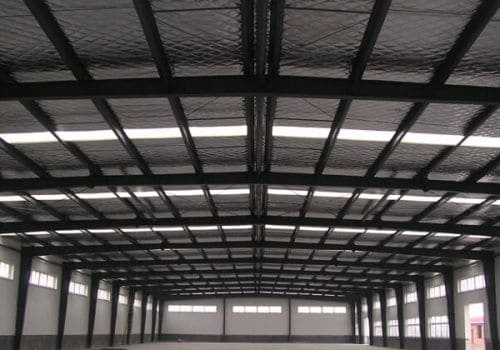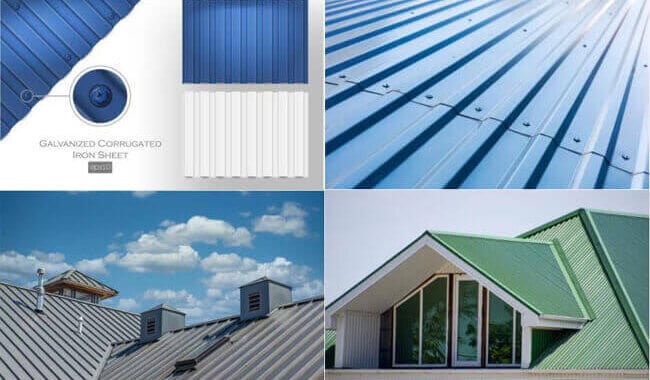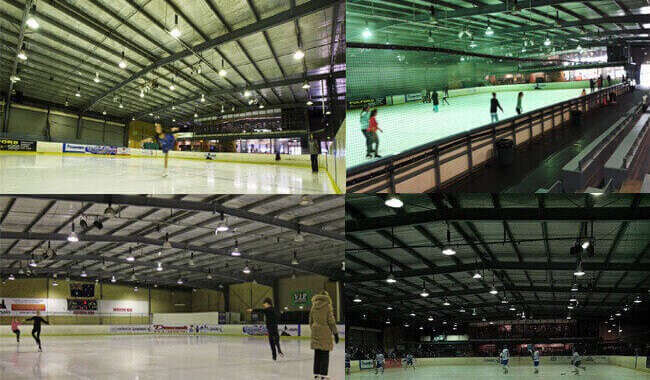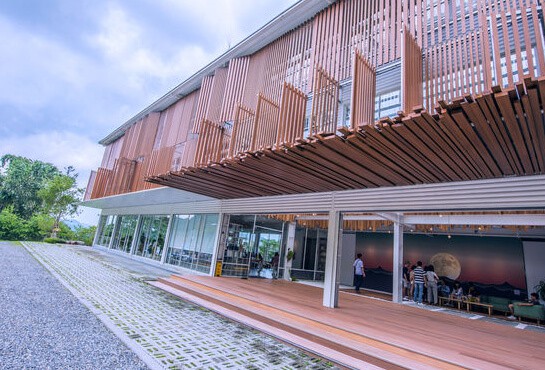The service life of steel structure buildings is more than 50 years. The roof and wall panels of prefabricated steel…
A steel frame building is a load-bearing framework composed of steel columns and steel beams fabricated by section steel or steel plates. The steel columns and steel beams are connected by bolts or welding, usually rigid connections.
Steel frame building belongs to the steel building and also belongs to frame structures. The steel column and the steel beam form a rectangular axis, the steel beam bears the horizontal load of the axis, and the steel column bears the vertical load. The steel frame structure needs to meet the strength and stability of the material and needs to ensure the overall rigidity of the frame to meet the design requirements.
Steel frame building composed of welded H-shaped steel and hot-rolled H-shaped steel as the main load-bearing skeleton, and C and Z section steel used for purlins and walls girt. The corrugated metal sheet use for roof and wall panels. Polystyrene foam, rigid polyurethane foam, rock wool, glass wool use as thermal insulation materials, and appropriate bracing light steel structure building systems.
The Beam and column of portal steel frames use welded h-shaped variable cross-section members. The beam-column joints of single-span portal frames rigidly connected, the multi-span portal frames are rigidly and hinged connected, the column feet can be rigidly or hinged connected with the foundation. The wall and roof panel use corrugated metal sheets. Thermal insulation materials used glass wool.
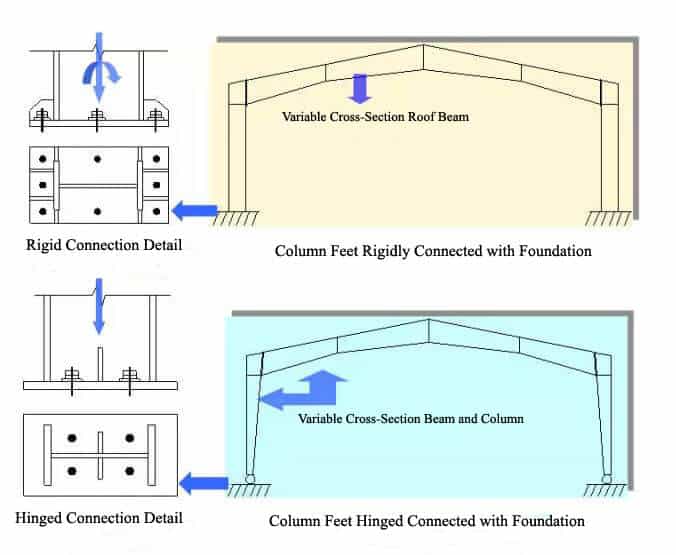
The forms of portal steel frame building:
The structural form of portal steel frames divided into the single span, double-span, and multi-span according to the span, and single ridge single slope, single ridge double slope, and multi-ridge multi-slope according to the number of roof ridges. The slope of the roof should be 1/20 to 1/8.
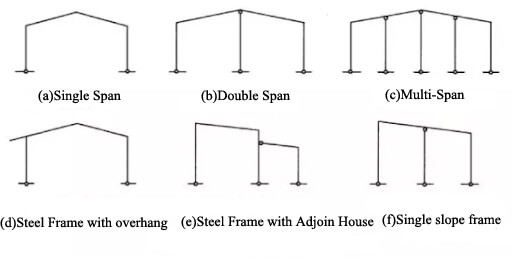
Structural Arrangement:
The arrangement of Portal Steel Frame Building
The span of the portal steel frame should be 9~36m. When the column width is not equal, the outside should be flush. The height should be determined according to the indoor net height, preferably 4.5 to 9m. The reasonable spacing of the steel structure frames should consider the span, load conditions, use requirements, and other factors, generally prefer 6m, 7.5m, and 9m.
The arrangement of Purlin and wall girt
The purlins spacing determined according to the calculation of the factors of the skylight, ventilated ridge, daylight panel, roofing panel, size of Purlin, and other factors. It should arrange at equal spacing, but one should arrange along each side of the ridge and one near the gutter. The arrangement of the sidewall girt should consider the set of doors, windows, eaves, canopies, and other components and the requirements of the enclosure materials.
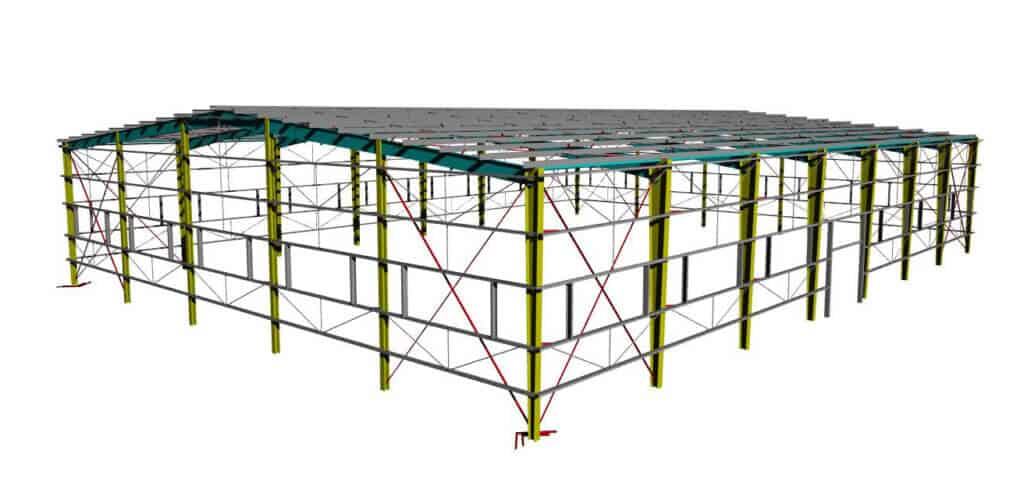
The arrangement of Bracings and Tie beam

- In each temperature zone or zone constructed in phases, it needs to arrange bracing systems that can independently form a spatially stable structure.
- In setting up the opening of the column bracing, the lateral bracing of the roof should be set at the same time to form a geometrically invariant system.
- The end bracing located in the first or second opening at the end of the temperature zone. The spacing between column bracing determined according to the longitudinal force of the building and installation conditions, generally 30 ~ 45m, and no more than 60m if with a crane.
- When the building is very tall, the column bracing should set in layers. When the width is over 60m, it needs to set column bracings.
- When the end bracing located in the second opening of the end, rigid rods shall place in the corresponding position of the first opening.
- At the turning points of the steel frame, the tie beam needs to set along the entire length of the building.
- For horizontal trusses consisting of bracing slanting rods, the straight belly rods should consider according to the rigid rods.
- Purlins can make stiff rods; at this time, the purlins should meet the load-bearing capacity and rigidity requirements of pressed bent members. If not satisfied, steel pipe, H-beam, or another cross-sectional form of the rod need set between the rigid frame inclined Beam.
9.When the building equipped with not less than 5t crane, the column bracing is suitable to use section steel. When the building is not allowed to set the column bracing, it should set the longitudinal steel frame.
Loads and load combinations
Permanent load
Permanent loads include the self-weight of structural members and the gravity loads of non-structural members suspended from the structure, such as roofs, purlins, bracings, suspended ceilings, wall members, and steel frames self weights.
Variable load
Variable loads include live roof loads (construction and maintenance concentrated loads should consider when designing roof panels and purlins), snow and ash loads on roofs, crane loads, seismic action, wind loads, etc.
Load combination
The load combination shall generally comply with the provisions of GB50009-2012, “Structural Load Design Code for Buildings,” and the following combination principles give in CECS102:2002 (2012 edition), “Technical Regulations for Portal Steel Frame Light House Steel Structure” for the characteristics of portal steel frames.
- Evenly distributed live roof loads are not considered together with snow loads, and the greater of the two should take into account.
- The ash load shall consider in conjunction with the larger of the snow load or the roofing uniform live loading.
- Construction or maintenance concentrated loads not considered in conjunction with loads other than the roofing material or purlins’ weight.
- The combination of more than one crane shall comply with the provisions of the “Design Code for Structural Load of Buildings.”
- When seismic action needs to consider, wind loads not found at the same time as seismic action.
Precautions in the design of Steel Frame Building
- Because the bending and torsional stiffness of the structural components of the portal steel frame is small, the overall stiffness of the structure is weak, so the design should consider the necessary measures to take during transportation and installation to prevent the bending and torsional deformation of the components.
- To pay attention to the bracing system and corner bracing arrangement, and also the roof panel, wall panels, and elements of the connecting structure, so that it can participate in the overall work of the structure.
- The rods that make up the structure member are thin. It needs to consider the requirements for production, installation, and transportation when design.
- The effect of corrosion on the weakened cross-section of structural members should fully consider in the design.
- The beam and column of the portal steel frame mostly adopt the variable section rod, the beam and column webs designed to take advantage of the bending strength, so the plastic design is no longer applicable.
- Consequences of light-weighting in the design must note and adequately addressed, such as the fact that wind can reverse the load on lightweight roof.
Precautions for Steel Structure Fabrication
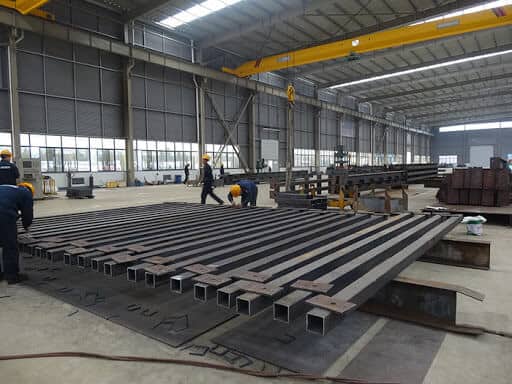
- The rust and dirt on the surface of the steel cutting area should remove before cutting, and the slag and splash should remove after gas cutting.
- The steel surface after correction shall not have a transparent concave surface or damage, and the depth of scratch shall not be over 0.5mm. For gas-cut or mechanically-sheared parts, when edge machining is required, the planing amount should not be less than 2.0mm.
- When drilling holes, the accuracy and allowable deviation of the bolt holes should comply with the specifications. When the permissible difference of the bolt holes exceeds the specs, it not allow steel block to plug. Can use the welding rod that matches the steel material to repair or re-weld to make new holes.
- When welding, do not use electrodes with peeled coatings or rusty welding cores, fluxes and agglomerated fluxes, and welded shells. Welding wires and nails should clean of oil and rust before use.
- When the grinding wheel treats the friction surface, the cracking range should not be less than four times the bolt hole diameter, and the grinding direction should be perpendicular to the stress direction of the component.
- The steel structure should shot blast before coating, the coating should be uniform, without visible wrinkling, sagging, and adhesion should be excellent. After the painted completed, the number of the component should mark on the steel structure.
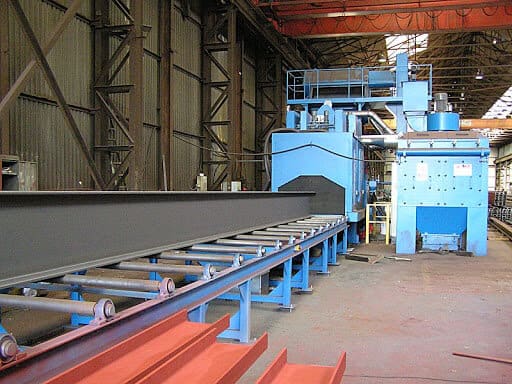
Precautions for The Installation of Steel Brame Building
- Before installing the steel structure, the quality of the steel member should check. The deformation and defects of the steel member should not exceed the allowable deviation. The measurement and correction of the steel member installation should base on the engineering characteristics.
- When the steel structure installed with an expanded assembly unit, the strength and stability of the steel members that are easily deformed should check. If necessary, reinforcement measures should take. After all steel components installed, a spatial rigidity unit should form.
- After the primary structure, such as columns, beams, roof trusses, and bracings of the steel structure installed in place, they should fix immediately. The installation of the steel structure should form a stable space system.
- When installing high-strength bolts, the bolts should penetrate freely into the holes and should not use as temporary installation bolts. The installation of high-strength bolts should be tightened in a specific order, preferably from the center of the bolt group, and should do a final twist on time.
The advantage of Steel Frame Building over Concrete Structure:
(1) Lightweight
Wall and roof panel made of corrugated single metal sheet, glass wool, and cold-formed thin-walled steel and other materials. The quality of the roof and wall is very light. The self-weight is only about 1/20 ~ 1/30 of the reinforced concrete structure under the same span and load. Due to the lightweight of the fabric, the foundation made smaller accordingly, and the cost of the foundation is lower.
(2) The high degree of industrialization and short construction period
The main components and accessories of the portal frame structure manufactured at the factory, and the quality is easy to guarantee, and the construction site is easy to install. Except for the basic construction, there is no wet operation. The connections between the components are mostly high-strength bolts, fast, and easy installation.
(3) The layout of the column is more flexible
The traditional reinforced concrete structure limited by the size of roof panels and wall panels. The column spacing is mostly 6 meters. When the column spacing is 12 meters, it will require brackets and wall bracket columns. The wall and roof panel of the portal steel frame uses corrugated metal plates, so the layout of the column grid is not limited by the modulus, and the size of the column distance mainly determined according to the requirements of use and the principle of the least amount of steel.










